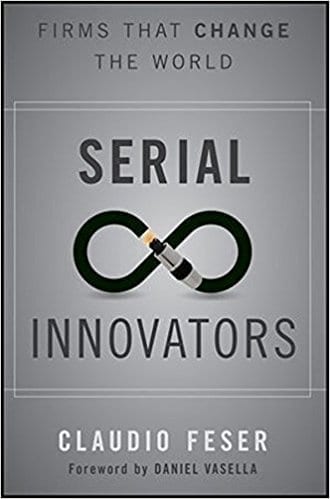Innovate or Die
Organizations cycle between exploration and exploitation. An exploration-oriented organization is full of innovation and creativity. It’s bursting with ideas, even if short on cash. Once an idea has manifested into a lucrative business model, the organization pivots to maximize revenue and efficiencies from the initial innovation, thus entering the exploitation phase. This creates an organizational lifecycle: organizations are born from one or more innovations, grow to effectively monetize their offering, and then face the choice: innovate again or die.
By the time the firm realizes that they face an innovation mandate, they’re often saddled with legacy infrastructures, legacy processes, and, more concerning, legacy culture. They develop rigidities in both systems and people. Only 14 of the top 50 U.S. firms ranked by sales in 1960 remained in the top 50 in 2010. The others were either outgrown and surpassed by smaller firms or they no longer exist.
Claudio Feser, author of Serial Innovators: Firms that Change the World, explores two root causes behind these rigidities. First is the nature of the human brain, which has a limited ability to see past the current paradigm or to adopt new mental models. This developed from an evolutionary need for quick decision-making and the need to act under time pressure. This first hurdle can cause blindness to the innovation imperative even at the executive leadership level.
The second is the organization itself. Structures, performance management systems, rewards and incentives, cultures, and capabilities within the organization can stop innovation in its tracks. While intrapreneurs within organizations may complain about bureaucratic systems, layers of processes, and committees, these may be necessary for a complex organization to function. The trick is to cultivate systems, processes, and cultures in a way that retains agility rather than rigidity.
Feser uses the story of a fictitious medical device manufacturer to illustrate seven interventions:
- Cultivating employees’ desire to make a difference.
- Building a team of learners at the top.
- Framing the vision and strategy positively.
- Building on self-managed performance cells.
- Promoting the employees’ drive to perform and grow.
- Investing in capabilities to quickly develop new assets and skills.
- Fostering a culture that values execution and embraces challenge.
One point he emphasizes is the value of a strong mission and vision rooted in helping each other and making the world a better place. His argument is that this vision is what empowers people to want to drive change and innovation.
However, when we look at the same list he references of the top 50 firms in the U.S., very few are especially well known for their altruistic nature. Walmart, Chevron, GM, and J.P. Morgan, to name a few, are better known for their exploitative practices, whether environmental, political, or in human capital.
Another counterexample is Amazon. Somewhat of a poster child for innovative and adaptive organizations, Amazon’s mission statement wouldn’t meet Feser’s standards. They have been plagued with negative coverage of their over-worked employees and vicious corporate culture, and yet Amazon thrives.
Reflecting on the book, one is left with a feeling that the supporting data was cherry-picked to support the book’s thesis. While the innovation imperative is a dilemma for many organizations, there isn’t a one-size-fits-all systematic approach. Organizational innovation and survival is equal parts visionary leadership, hard work, and the good fortune to be in the right place at the right time with the right people to make it all happen.

